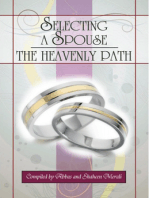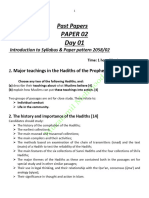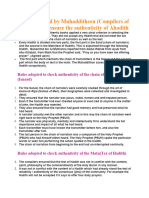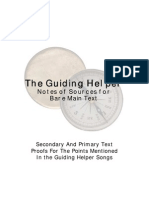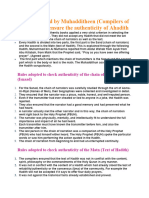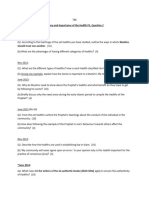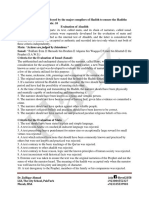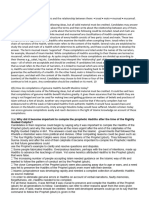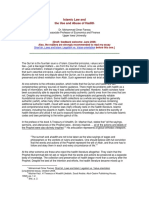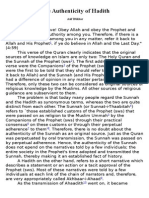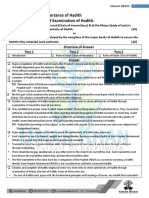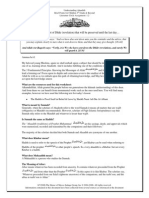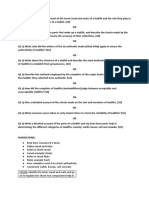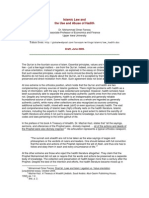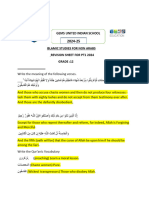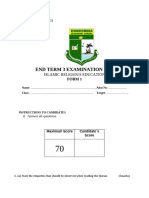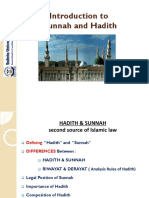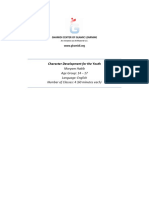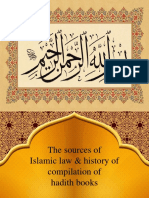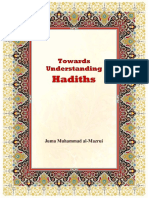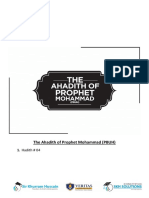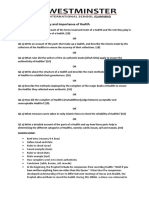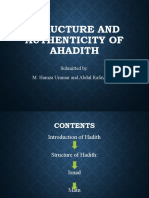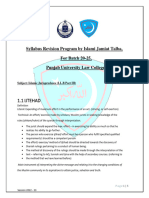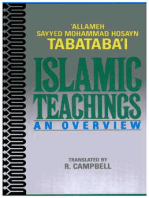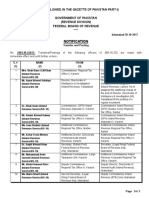0 ratings0% found this document useful (0 votes)
31 viewsIslamiat Notes
Islamiat Notes
Uploaded by
Hashir ShaheerThe compilers of the six authentic hadith books very strictly evaluated hadiths before including them. They checked both the chain of narrators (isnad) and the text (matn) of each hadith. The isnad was scrutinized by studying the biographies of each narrator to confirm their reliability, honesty, and ability to accurately transmit the hadith. The matn was ensured to not contradict the Quran, other established hadiths, historical facts, logic, or Islamic principles. This rigorous verification of isnad and matn was crucial to authenticate the hadiths.
Copyright:
© All Rights Reserved
Available Formats
Download as DOCX, PDF, TXT or read online from Scribd
Islamiat Notes
Islamiat Notes
Uploaded by
Hashir Shaheer0 ratings0% found this document useful (0 votes)
31 views5 pagesThe compilers of the six authentic hadith books very strictly evaluated hadiths before including them. They checked both the chain of narrators (isnad) and the text (matn) of each hadith. The isnad was scrutinized by studying the biographies of each narrator to confirm their reliability, honesty, and ability to accurately transmit the hadith. The matn was ensured to not contradict the Quran, other established hadiths, historical facts, logic, or Islamic principles. This rigorous verification of isnad and matn was crucial to authenticate the hadiths.
Copyright
© © All Rights Reserved
Available Formats
DOCX, PDF, TXT or read online from Scribd
Share this document
Did you find this document useful?
Is this content inappropriate?
The compilers of the six authentic hadith books very strictly evaluated hadiths before including them. They checked both the chain of narrators (isnad) and the text (matn) of each hadith. The isnad was scrutinized by studying the biographies of each narrator to confirm their reliability, honesty, and ability to accurately transmit the hadith. The matn was ensured to not contradict the Quran, other established hadiths, historical facts, logic, or Islamic principles. This rigorous verification of isnad and matn was crucial to authenticate the hadiths.
Copyright:
© All Rights Reserved
Available Formats
Download as DOCX, PDF, TXT or read online from Scribd
Download as docx, pdf, or txt
0 ratings0% found this document useful (0 votes)
31 views5 pagesIslamiat Notes
Islamiat Notes
Uploaded by
Hashir ShaheerThe compilers of the six authentic hadith books very strictly evaluated hadiths before including them. They checked both the chain of narrators (isnad) and the text (matn) of each hadith. The isnad was scrutinized by studying the biographies of each narrator to confirm their reliability, honesty, and ability to accurately transmit the hadith. The matn was ensured to not contradict the Quran, other established hadiths, historical facts, logic, or Islamic principles. This rigorous verification of isnad and matn was crucial to authenticate the hadiths.
Copyright:
© All Rights Reserved
Available Formats
Download as DOCX, PDF, TXT or read online from Scribd
Download as docx, pdf, or txt
You are on page 1of 5
Methods used by Muhadditheen (Compilers of Ahadith) to ensure
the authenticity of Hadith
• The compilers of six authentic books applied a very strict
criterion in selecting the Ahadith for their books. They did not
accept any Hadith that did not meet the set criteria. They checked
the chain of narrators as well as the text.
• Every Hadith is divided into two parts, the first part is the Sand
(chain of narrators) and the second is the Matn (text of Hadith).
This is explained through the following Hadith, Muhammd bin Al
Muthanna reported from Abdul Wahab from Ayub from Abu
Killabah, from Malik that the Prophet (PBUH) said, “Pray as you
have seen me offering prayer”. (Agreed upon)
The first part which mentions the chain of transmitters is the
Sanad and the second part which the body or text is the Matn.
The Muhaddithun assessed both parts of the Hadith scrupulously.
Rules adopted to check authenticity of the chain of narrators
(Isnaad)
1. For the Sanad, the chain of narrators were carefully studied
through the art of Asma-Ur-Rijal. (Asma-ur Rijal refers to the
biographies related to the standing of narrators relating to their
narrating ability. In this branch of knowledge more than five lac
narrator’s biographies were collected and investigated in detail.
2. Every narrator in chain must be an “Aadil Muslim” which means
that he must be pious, noble and honest, God fearing and well-
reputed Muslim.
3. The name, nick name, tittle, parentage, and occupation of the
narrator should be known.
4. The narrator should not have been accused of having lied,
giving false evidence or committing a crime; otherwise there are
more chances that he could bring changes in hadith to his false
nature.
5. Even if the transmitter had ever cheated anyone or even lied to
anyone in the matter of joke, the Hadith is rejected.
6. It must be ensured that narrator had good memory and had
preserved what he had heard.
7. Every narrator who refers his hadith to another narrator should
have lived in the same period and must meet the other narrator.
In this way the chain of narrators must go right back to the Holy
Prophet (PBUH).
8. The narrator must have been physically, mentally and
intellectually fit to understand and remember the full importance
and impact of all what he had heard. Narrator must be of an age
at which he could understand the full importance of Hadith.
9. Each transmitter must have known the transmitter before him,
and also the transmitter after him.
10. The original narrator (last transmitter) in the chain of narrators
must be a companion of the Holy Prophet (PBUH) who had
himself either heard The Holy Prophet (PBUH) spoke the
particular words or seen him performing the action quoted in the
Hadith.
11. The chain of narration from beginning to the end had un-
interrupted continuity.
Rules adopted to check authenticity of the Matn(Tex of Hadith)
1. The compilers ensured that the text of Hadith should not be in
conflict with the content, spirit, philosophy or the commandments
of the Holy Quran in any manner.
2. It should not in conflict with the content of a Hadith which had
already stood the test of reliability / authenticity or the consensus
(Ijma) of the community. For example the Hadith will not be
accepted if it says to offer four daily prayers.
3. It should not be against the historical facts already established
and proved.
4. It should not be against the dictates of human reasoning, logic,
known principles of human society, rationale of common sense or
the laws of nature. For instance, “brushing teeth increases
wisdom” or Hadith about Auj bin Anaq is rejected due to its
unnatural text.
5. The Matn (Text) should have pure Arabic text in Quraish’s
dialect as the Prophet’s (PBUH) language was pure and perfect.
6. It must not, in any way, hurl accusation or derogatory to the
Holy Prophet (PBUH), his family and companions.
7. The Hadith which promised a high reward for a small virtue, or
severe punishment for the minor sins was rejected.
8. The text which referred to actions which that should have been
commonly known and practiced by others but they were not
known and practiced is rejected.
9. A Hadith reported by large number of people in different times
whose agreement on lie is became inconceivable was accepted.
In short Hadith researchers paid critical attention to the science of
biographies and criticism (Asma’ al Rijal) of the hadith narrators in
each generation. And so, narrators of hadith (isnad) were
subjected to severe tests and were graded according to varying
degrees of reliability and genuineness depending upon their
character, religious reputation and orientation, depth of
knowledge, and the soundness and accuracy of their memories.
Q4 (a) Write an account of the benefits that result from the
payment of charity (zakat ), and state to whom it should
and should not be paid.
(b) In your opinion, what is the greatest benefit for the
giver of zakat ? Give reasons to support your answer.
Q4 (a) Outline the practice of almsgiving (zakat ) in Islam.
(b) Who do you think benefits more from the payment of
zakat and why, the giver or the receiver?
2 (a) What rules did the writers of the six authentic books
(Sihah Sitta) apply to ensure the authenticity of Hadiths?
[10] The writers of the six authentic books applied a very
strict criteria in selecting the Hadiths for their books could
be a simple start to this answer. Candidates need to give
accurate information about the methods they employed of
scrutinising isnad and matn. To get to the higher levels
candidates will also need to write in some detail about how
the compilers compared the body (matn) of the Hadith with
reason, the Qur’an and other Hadiths to ensure that it
agreed with the main Islamic principles. The importance of
the chain of narrators (isnad) being unbroken could well
be mentioned as well as the need to ensure that the
narrator was of a sound mind, with a good memory and
exemplary moral character. Examples of narrators going
about collecting Hadiths could also be cited in well
developed responses.
(b) Why in your opinion was it important for them to apply
these rules? [4] This is an evaluative answer and
candidate’s responses should reflect their understanding
of why it was deemed important to catalogue authentic
Hadiths by the writers and perhaps reflect upon what
could have been the possible dangers of not doing so.
5 (a) How are the individuals and the community benefited
by almsgiving (zakat)? [10] Zakat is the fourth pillar of
Islam and its benefits, both personal and communal, are
many. Some of the benefits of zakat the candidates can
refer to may be: The payment of zakat purifies the heart of
the giver of love of wealth, greed and miserliness and
inculcates the love of God; it is a blessing for both the
giver and the receiver; zakat expiates the sins of a person;
it leads to equal distribution of wealth in society and
prevents accumulation of wealth in a few hands; it fosters
goodwill, brotherhood and equality in the community;
zakat stimulates investment and discourages hoarding, if
people do not invest their wealth it will gradually get
consumed by zakat. Hence it is an effective way to keep
wealth in circulation. Benefits other than those given
above could be given by the candidates. Also
development of the benefits, backed by quotes from the
Qur’an and the Prophet’s Hadiths about the benefits of
zakat could be cited by the candidates and this
development could, based on the answer as a whole, take
the candidates up to the higher levels.
You might also like
- Abu Qanit Al-Hasani - Sources of The Notes of The Guiding HelperDocument966 pagesAbu Qanit Al-Hasani - Sources of The Notes of The Guiding HelperTalibeNo ratings yet
- Book - Ethics by GordonDocument244 pagesBook - Ethics by Gordonumerfr2100% (6)
- Accounting ProjectDocument107 pagesAccounting Projectapi-353552300100% (2)
- AL-KAFI VOLUME 3 (English) PDFDocument654 pagesAL-KAFI VOLUME 3 (English) PDFDhulfikarETayyar100% (1)
- NCP Altered ComfortDocument2 pagesNCP Altered ComfortColleen De la Rosa50% (2)
- ISNAD MATAN Methods of Examining AhadeesDocument9 pagesISNAD MATAN Methods of Examining AhadeesHumtyPlaysNo ratings yet
- Combined Notes P2Document149 pagesCombined Notes P2The QueenNo ratings yet
- Hadith AutheticityDocument2 pagesHadith AutheticityKing LolNo ratings yet
- Past Papers P2 Day 02 March 2021Document8 pagesPast Papers P2 Day 02 March 2021Waleed AftabNo ratings yet
- Guiding Helper - Sources For LyricsDocument785 pagesGuiding Helper - Sources For Lyricss toure100% (2)
- Hadith AutheticityDocument2 pagesHadith AutheticityAmna AmerNo ratings yet
- History and Importance of HadithDocument13 pagesHistory and Importance of Hadithabdeali bhaijeeNo ratings yet
- The Authenticity of Hadith - Asif IftikharDocument11 pagesThe Authenticity of Hadith - Asif IftikharRMRE UETNo ratings yet
- Histtory and Importance of HadithDocument31 pagesHisttory and Importance of HadithAbdullah AhsanNo ratings yet
- Evaluation of AhadithDocument2 pagesEvaluation of AhadithHasan MehmoodNo ratings yet
- Introduction of HadithDocument3 pagesIntroduction of HadithAyesha jalalNo ratings yet
- Histort Hadeeth Ms 2015-23Document14 pagesHistort Hadeeth Ms 2015-23aaminaftmaNo ratings yet
- Four Myths About Hadiths, and Proof That Even Sahih Hadiths Are NOT 100% TrueDocument24 pagesFour Myths About Hadiths, and Proof That Even Sahih Hadiths Are NOT 100% Trueshees1993100% (1)
- Sir Muzamil Notes Paper 2Document9 pagesSir Muzamil Notes Paper 2Muqeet QaiserNo ratings yet
- The Authenticity of HadithDocument8 pagesThe Authenticity of HadithPrashant LounganiNo ratings yet
- AL-KAFI VOLUME 7 (English) PDFDocument371 pagesAL-KAFI VOLUME 7 (English) PDFDhulfikarETayyar100% (1)
- Isnad and MatanDocument2 pagesIsnad and MatanAiman Imran0% (1)
- History and Importance of Hadith (Short Questions)Document3 pagesHistory and Importance of Hadith (Short Questions)yusrayameenNo ratings yet
- AL-KAFI VOLUME 4 (English) PDFDocument698 pagesAL-KAFI VOLUME 4 (English) PDFDhulfikarETayyar100% (1)
- Past Paper Question On History and Importance of HadithDocument10 pagesPast Paper Question On History and Importance of Hadithsaad nadeemNo ratings yet
- Grade 11 - Notes - AnnualDocument9 pagesGrade 11 - Notes - AnnualRifatNo ratings yet
- History and Importance of Hadith Full New UpdatedDocument16 pagesHistory and Importance of Hadith Full New Updatedhania aijazNo ratings yet
- Understanding Ahaadith-Brief Points For Children 1.2Document2 pagesUnderstanding Ahaadith-Brief Points For Children 1.2bint_shamsNo ratings yet
- HadithDocument15 pagesHadithsana khawajaNo ratings yet
- CH 6 Authenticity of HadithDocument17 pagesCH 6 Authenticity of HadithSpecsNo ratings yet
- Islamiyat PP Topical P2Document32 pagesIslamiyat PP Topical P2Umar100% (1)
- Aqidah Islamiyyah and Contemporary Challenges: FitrahDocument3 pagesAqidah Islamiyyah and Contemporary Challenges: FitrahfikriNo ratings yet
- 0 - Sanad and MatnDocument3 pages0 - Sanad and MatnmaryamNo ratings yet
- AL-KAFI VOLUME 6 (English) PDFDocument721 pagesAL-KAFI VOLUME 6 (English) PDFDhulfikarETayyarNo ratings yet
- CHAPTER 3.2 - Sources of Shariah-Al-Sunnah-doneDocument37 pagesCHAPTER 3.2 - Sources of Shariah-Al-Sunnah-doneNurfa AhzaNo ratings yet
- Mock 2024 Review MS p2Document7 pagesMock 2024 Review MS p2shk.saad.zafarNo ratings yet
- DBQ Belief SystemsDocument6 pagesDBQ Belief Systemsapi-213324377No ratings yet
- Taken From:: Islamic Law and The Use and Abuse of HadithDocument16 pagesTaken From:: Islamic Law and The Use and Abuse of HadithAbdullahNo ratings yet
- Presentasi DeductionDocument3 pagesPresentasi DeductionEka Mega PertiwiNo ratings yet
- Rules To Check The Authenticity of Hadith With ExamplesDocument1 pageRules To Check The Authenticity of Hadith With ExamplesBushra HanifNo ratings yet
- Ans Key Grade 12 Revision Sheet pt1 2024-25Document9 pagesAns Key Grade 12 Revision Sheet pt1 2024-25muaazbloxNo ratings yet
- Ire F1 2024Document6 pagesIre F1 2024Kiwayuu islandNo ratings yet
- Introduction To Sunnah and HadithDocument26 pagesIntroduction To Sunnah and HadithMuhammad ArhamNo ratings yet
- Character Development For The Youth SyllabusDocument9 pagesCharacter Development For The Youth SyllabusAayan S. AbbasiNo ratings yet
- The History and Importance of AhadisDocument7 pagesThe History and Importance of AhadisAreeba NaseerNo ratings yet
- Islamiyat PresentationDocument26 pagesIslamiyat PresentationHira FatimaNo ratings yet
- Towards Understanding Hadiths-C87D3Document48 pagesTowards Understanding Hadiths-C87D3Blup BlupNo ratings yet
- Hadith # 04Document3 pagesHadith # 04Muniza Haseeb Khan - 69263/TCHR/BKDCNo ratings yet
- Sanad and Matn Updated by SanaDocument3 pagesSanad and Matn Updated by Sanahania aijazNo ratings yet
- Methods Used by MuhadditheenDocument2 pagesMethods Used by MuhadditheenAizaz SattiNo ratings yet
- Structure and Authenticity of AhadithDocument14 pagesStructure and Authenticity of AhadithHamza UmmarNo ratings yet
- Ijtehad IslmcJur LL B3 23 IJTDocument5 pagesIjtehad IslmcJur LL B3 23 IJTBajwa Sab (Neat People)No ratings yet
- Biographical EvaluationDocument23 pagesBiographical EvaluationNabeelNo ratings yet
- Islamiat Comprehenive Worksheet Paper 2 Class 9 2019 Ans KeyDocument10 pagesIslamiat Comprehenive Worksheet Paper 2 Class 9 2019 Ans Keyeishaal2410No ratings yet
- Difference Between Hadith and SunnahDocument9 pagesDifference Between Hadith and Sunnahelan sudjanamihardjaNo ratings yet
- Hadths 1-20Document20 pagesHadths 1-20Faizan KhanNo ratings yet
- History and Importance of HadithDocument20 pagesHistory and Importance of HadithJoydeep KumarNo ratings yet
- Hadith and SunnahDocument4 pagesHadith and Sunnahrabeet notofficialNo ratings yet
- HadithDocument20 pagesHadithguestposter29No ratings yet
- Holy Quran’S Judgement – Part 1: (English Translation of the Book “Thirukkuran Theerpu – Part 1”Tamil)From EverandHoly Quran’S Judgement – Part 1: (English Translation of the Book “Thirukkuran Theerpu – Part 1”Tamil)No ratings yet
- Islamic Teachings: An OverviewFrom EverandIslamic Teachings: An OverviewRating: 3 out of 5 stars3/5 (1)
- Grade XI Bi Monthly Syllabus (Oct 2023-24)Document3 pagesGrade XI Bi Monthly Syllabus (Oct 2023-24)Hashir ShaheerNo ratings yet
- Cambridge O Level: Accounting 7707/24 May/June 2021Document17 pagesCambridge O Level: Accounting 7707/24 May/June 2021Hashir ShaheerNo ratings yet
- P2 Market StructuresDocument4 pagesP2 Market StructuresHashir ShaheerNo ratings yet
- Economics (2281) Chapter 4Document20 pagesEconomics (2281) Chapter 4Hashir ShaheerNo ratings yet
- Believer (Imagine Dragons) - 2017Document1 pageBeliever (Imagine Dragons) - 2017James DerekNo ratings yet
- Summative Test I.A6 Q1 M45Document1 pageSummative Test I.A6 Q1 M45Asorihm MhirosaNo ratings yet
- Positive Aspects of Phil. ValuesDocument13 pagesPositive Aspects of Phil. ValuesJaymar MagtibayNo ratings yet
- Bab 1308 Research Methods in BusinessDocument2 pagesBab 1308 Research Methods in Businesskuriamartin20No ratings yet
- INTRODUCTIONDocument2 pagesINTRODUCTIONEldonVinceIsidroNo ratings yet
- CV Nikola MitrovicDocument2 pagesCV Nikola MitrovicnidzomirNo ratings yet
- ARL-700 Quick Installation Guide.V120.en PDF Electric Motor ElevatorDocument1 pageARL-700 Quick Installation Guide.V120.en PDF Electric Motor Elevatordejan.bimbeNo ratings yet
- The Modelling News - in Review - Ampersand Publishing's D7 Tractor - A Visual History Book.Document7 pagesThe Modelling News - in Review - Ampersand Publishing's D7 Tractor - A Visual History Book.Mark AbNo ratings yet
- TNV 766 PDFDocument280 pagesTNV 766 PDFSatyabrat DuttaNo ratings yet
- 2014 - Jan Otto - EEDI VerificationDocument20 pages2014 - Jan Otto - EEDI Verificationhamedullah mNo ratings yet
- Homeroom GuidanceDocument5 pagesHomeroom GuidanceKim UnalanNo ratings yet
- Egain11 4 Results First AnalyticsDocument35 pagesEgain11 4 Results First AnalyticsErnestNo ratings yet
- Learning Outcome: Evaluator's Comments (For Instructor's Use Only)Document5 pagesLearning Outcome: Evaluator's Comments (For Instructor's Use Only)Neel PrasantNo ratings yet
- William James' Four Characteristics of Mystical Experience: IneffableDocument11 pagesWilliam James' Four Characteristics of Mystical Experience: IneffableRuel ArancesNo ratings yet
- CV300 2Document13 pagesCV300 2Achariya ParpromNo ratings yet
- Sbi Fy-23.24Document8 pagesSbi Fy-23.24Bitla SaikiranNo ratings yet
- Project Planning & SchedulingDocument1 pageProject Planning & Schedulinguandme77No ratings yet
- Practical Exercises Raúl CarballoDocument9 pagesPractical Exercises Raúl CarballoAlfonso MartínezNo ratings yet
- Accessories: Fields of Application Professional Ground ScrewsDocument18 pagesAccessories: Fields of Application Professional Ground ScrewsMarta GameiroNo ratings yet
- University of Northern Philippines: IndividualDocument7 pagesUniversity of Northern Philippines: IndividualRoselyn Lazaro TamayoNo ratings yet
- 6th STD Social Science Indus CivilisationDocument3 pages6th STD Social Science Indus CivilisationS.P. SIVAKAMALINo ratings yet
- Screenshot 2024-01-29 at 19.03.05Document20 pagesScreenshot 2024-01-29 at 19.03.0547z597rcf6No ratings yet
- English Project Topics 2023-24Document5 pagesEnglish Project Topics 2023-24Pratyush Jain75% (8)
- Curriculum VitaeDocument2 pagesCurriculum VitaeQuindap JonalineNo ratings yet
- EMTEC-Applied Subject-Quiz Bee QuestionsDocument1 pageEMTEC-Applied Subject-Quiz Bee QuestionsBee NeilNo ratings yet
- SWOT ANALYSIS of Agro Chemical IndustryDocument4 pagesSWOT ANALYSIS of Agro Chemical Industryjaya rani dasNo ratings yet
- Workers Welfare Fund Ordinance 1971Document3 pagesWorkers Welfare Fund Ordinance 1971Mujahid iqbalNo ratings yet
